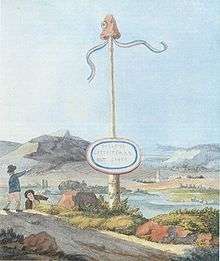Liberty pole

A liberty pole is a tall wooden pole, often used as a type of flagstaff, planted in the ground, surmounted by a Phrygian cap. The symbol originated in the immediate aftermath of the assassination of Roman dictator Julius Caesar by a group of Rome's Senators in 44 BC.[1] Immediately after Caesar was killed, the leaders of the assassination plot went to meet a crowd of Romans at the Roman Forum; a pileus (a kind of skullcap that identified a freed slave) was placed atop a pole to symbolize that the Roman people had been freed from the rule of Caesar, which the assassins claimed had become a tyranny because it overstepped the authority of the Senate and thus betrayed the Republic.[2] During the French revolution, the Roman pileus was confused with the Phrygian cap, and this mis-identification then led to the use of the Phrygian cap as a symbol of republicanism.
American Revolution

Liberty poles were often erected in town squares in the years before and during the American Revolution (e.g. Concord, Massachusetts; Newport, Rhode Island; Caughnawaga, New York; Savannah, Georgia and Englewood, New Jersey[3]). Some colonists erected liberty poles on their own private land (such as in Bedford, Massachusetts since 1964 and Woburn, Massachusetts—the pole raising there is reenacted annually). An often violent struggle over liberty poles erected by the Sons of Liberty in New York City raged for 10 years. The poles were periodically destroyed by the royal authorities (see the Battle of Golden Hill), only to be replaced by the Sons with new ones. The conflict lasted from the repeal of the Stamp Act in 1766 until the revolutionary New York Provincial Congress came to power in 1775.[4] The liberty pole in New York City had been crowned with a gilt vane bearing the single word, "Liberty".
In some locales—notably in Boston—a liberty tree rather than a pole served the same political purpose.
During the Siege of Boston on August 1, 1775, a tall liberty pole was erected on Prospect Hill, a fortified high-ground overlooking the road to British-occupied Boston.[5] Both the "Appeal to Heaven" Pine Tree Flag and Grand Union Flag (aka Continental Colors) are reported to have flown on Prospect Hill.[6][7] The 76' long liberty pole was originally a ship's mast that had been recently captured[8] from the British armed schooner HMS Diana (1775), in the aftermath of the Battle of Chelsea Creek on May 27 and 28, 1775.
When an ensign was raised (usually red) on a liberty pole, it would be a calling for the Sons of Liberty or townspeople to meet and vent or express their views regarding British rule. The pole was known to be a symbol of dissent against Great Britain. The symbol is also apparent in many seals and coats of arms as a sign of liberty, freedom, and independence.
Other uses

During the Whiskey Rebellion, locals in western Pennsylvania would erect poles along the roads or in town centers as a protest against the federal government's tax on distilled spirits, and evoke the spirit embodied by the liberty poles of decades earlier.[9]
The arbres de la liberté ("liberty trees") were a symbol of the French Revolution, the first being planted in 1790 by a pastor of a Vienne village, inspired by the 1765 Liberty Tree of Boston. One was also planted in front of the City Hall of Amsterdam on 4 March 1795, in celebration of the alliance between the French Republic and the Batavian Republic. In 1798, with the establishment of the short-lived Roman Republic, a liberty tree was planted in Rome's Piazza delle Scole, to mark the legal abolition of the Roman Ghetto. After resumption of Papal rule, the Vatican reinstated the Roman ghetto.
The image of Liberty holding a pole topped by a Phrygian cap appears on many mid- and late-19th-century U.S. silver coins. These are broadly classified as United States Seated Liberty coinage.
In 1945, following the liberation of the Netherlands from Nazi occupation in World War II, a liberty pole was erected on Dam Square in Amsterdam. The form of the permanent National Monument later erected on the spot (a stone pillar) might have been influenced by that pole.
Places
- Liberty Pole, Wisconsin, unincorporated community, United States
See also
References
| Wikimedia Commons has media related to Freedom trees. |
- ↑ Adrian Goldsworthy. Caesar: Life of a Colossus. Paperback edition. London, England, UK: Phoenix, 2007. Pp. 596-619.
- ↑ Adrian Goldsworthy. Caesar: Life of a Colossus. Paperback edition. London, England, UK: Phoenix, 2007. Pp. 619.
- ↑ Historic Englewood City of Englewood
- ↑ Resistance and Dissent : Independence & its Enemies in New York
- ↑ Journal kept by continental soldier Lieutenant Paul Lunt, May-December 1775 "raised the mast that came out of the schnoner that was burnt at Chelsea, for to hoist our flag upon, in the fort upon Prospect Hill".
- ↑ The Writings of George Washington from the Original Manuscript Sources 1745-1799, Vol. 4: To JOSEPH REED Cambridge, January 4, 1776.
- ↑ Paul Lunt's Diary, Lieutenant Paul Lunt, May–December 1775, Tuesday, July 18, 1775, "Our standard was presented in the midst of the regiments with this inscription upon it, "Appeal to Heaven."
- ↑ Revolutionary War Soldier's Journal/Diary in the Longfellow House Collections, Moses Sleeper, Tuesday, August 1st, 1775 "Raised the mast that Came out of the Schooner that was burnt at Chelsa" .
- ↑ Baldwin, Leland Dewitt (1968). Whiskey rebels: the story of a frontier uprising. University of Pittsburgh Press. p. 208.